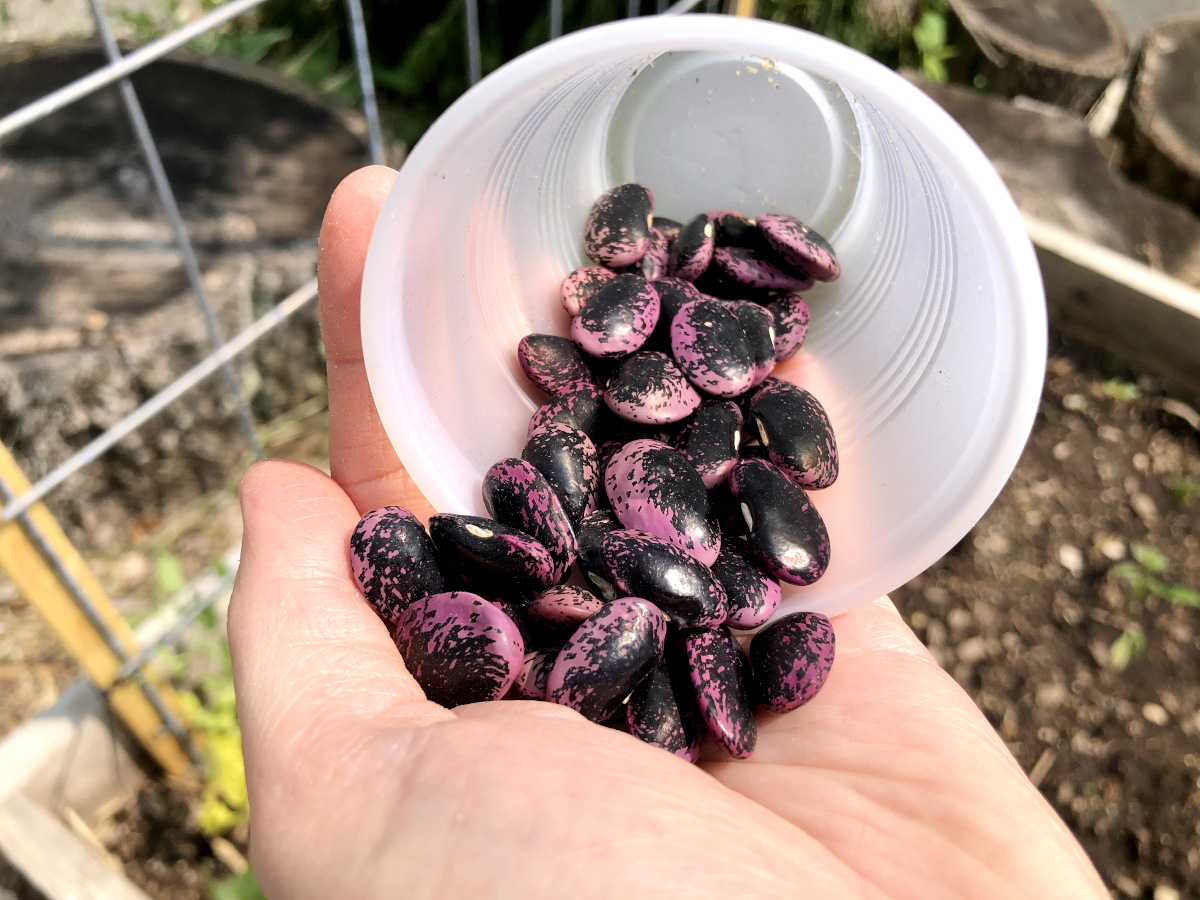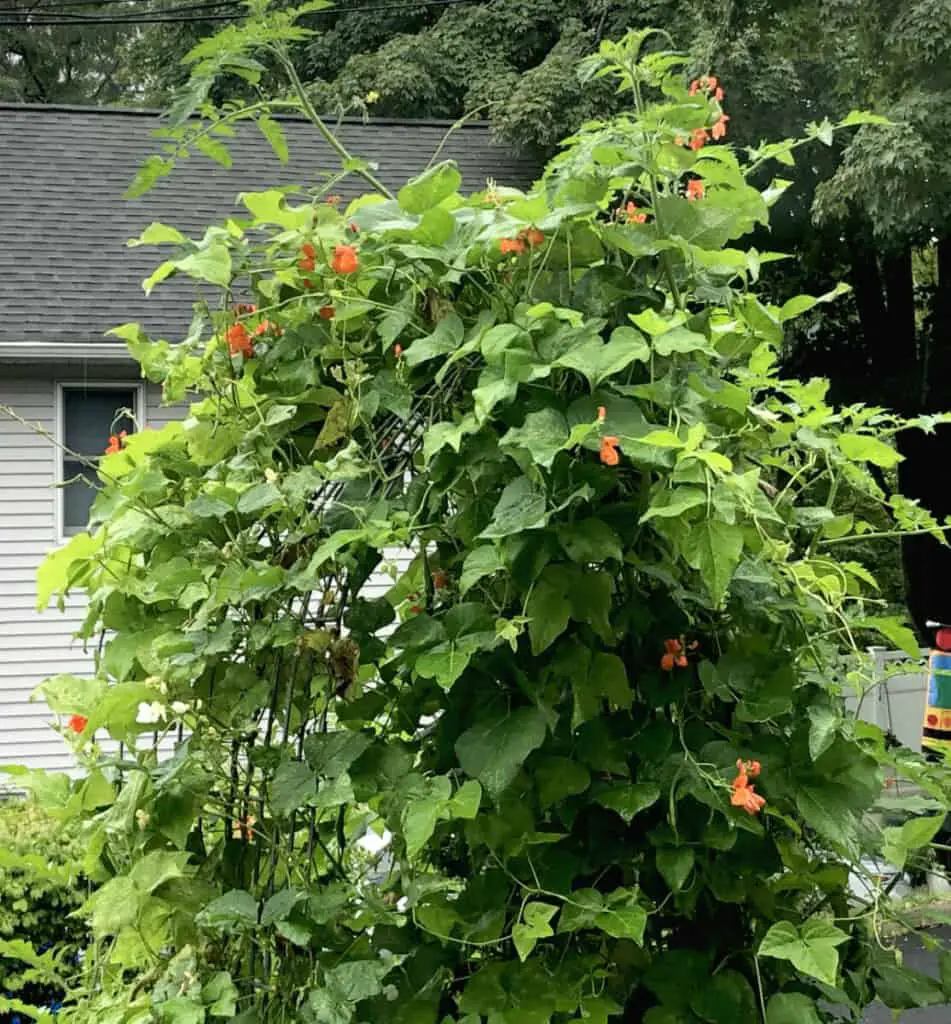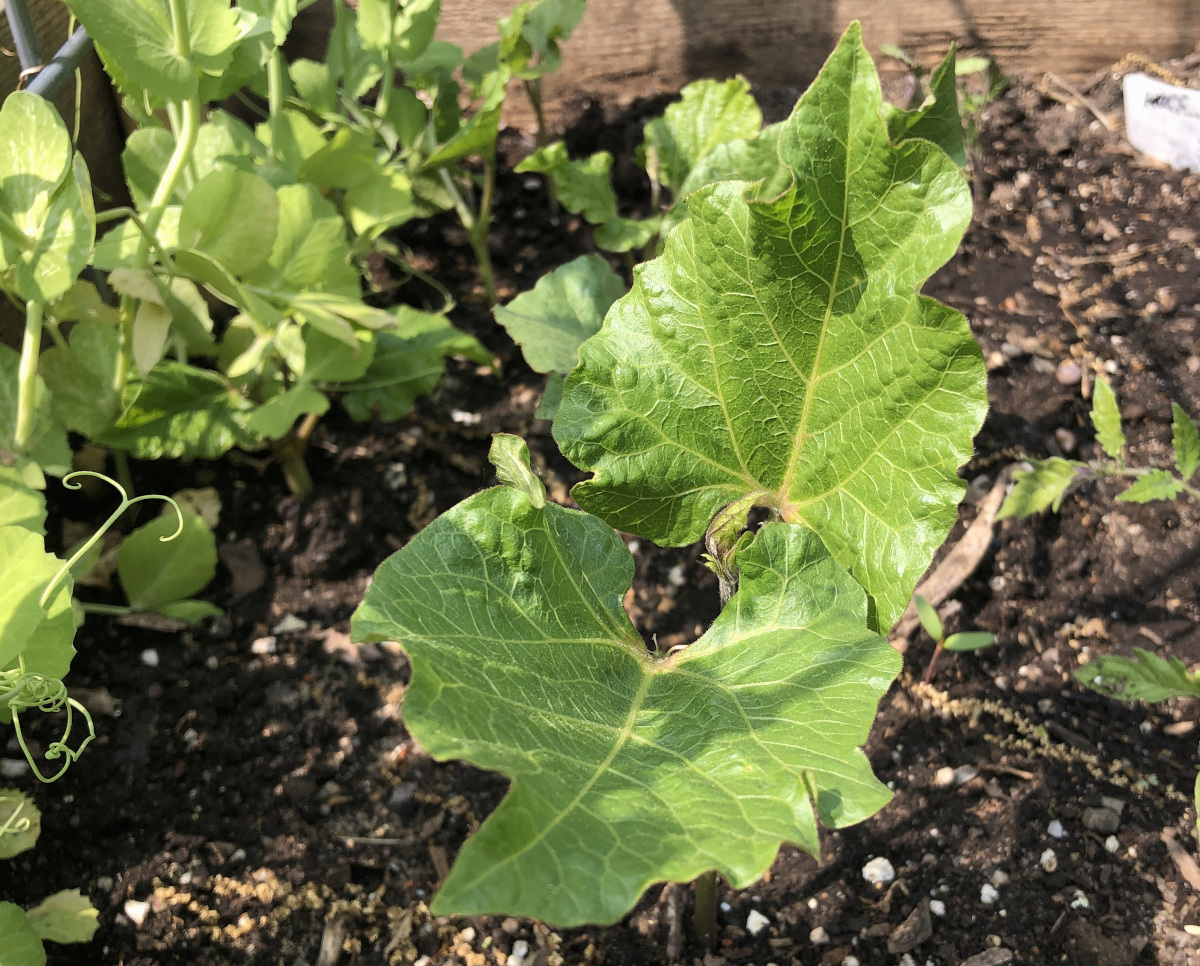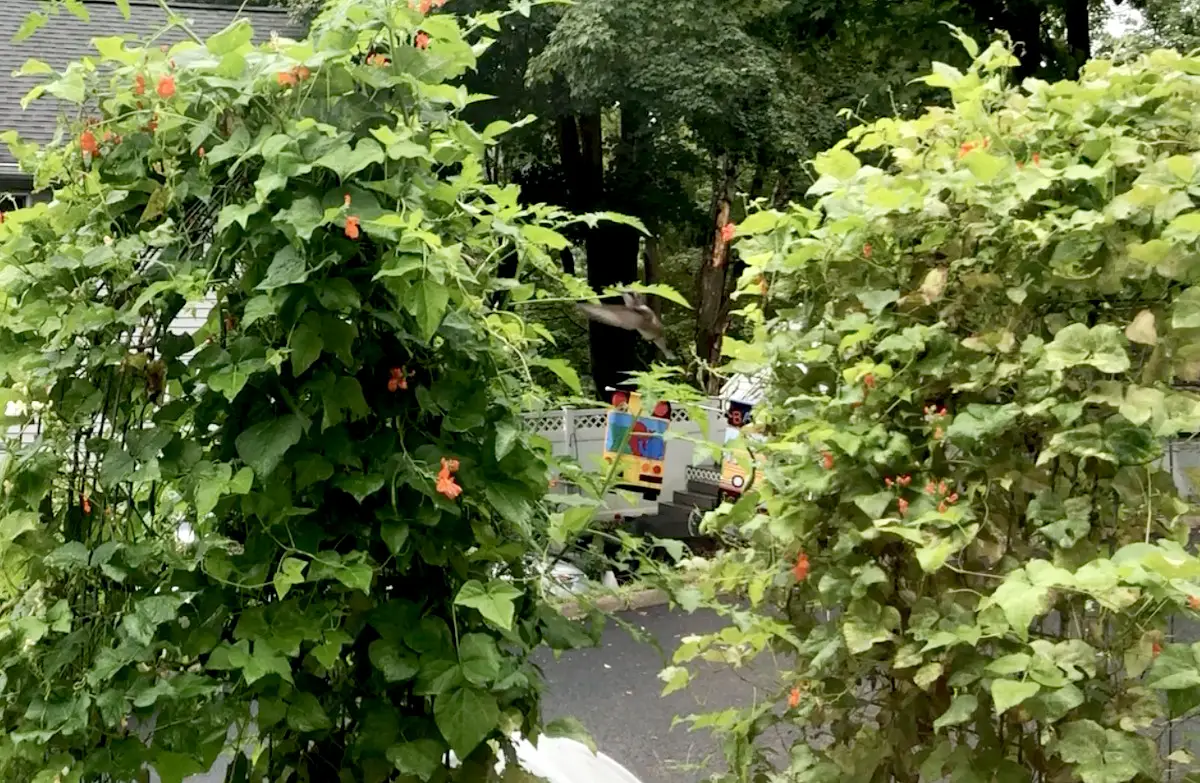Large buttery beans are one of my favorite things to eat! When I was a child, I used to ladle them up from the bottom of the pot full of bean soup and saved them to enjoy them the very last. Pole beans are also one of my favorite crops to grow in my garden because they are such forgiving plants. They require no babysitting, no pampering, and they look so stunning when in full bloom. They attract pollinators and hummingbirds. During the hot summer, they flower heavily even though the plant’s production is shut, I still enjoy flowers and bean plant display on trellises. Once the temperatures fall down, the plant starts to produce again.
- Select a sunny location. Beans like the sun, the more the better. Pole beans produce best when they receive at least 6-8 hours of sunlight.
- Select a location with well-draining, fertile, and loamy soil. If needed, till the soil, so it is not compacted.
- If needed, amend the soil if organic matter like compost, aged animal manure, or slow-release fertilizer. Or use trench composting over the winter to deposit organic matter directly in the garden bed.
- Plant beans directly in the ground in their permanent spot. When sowing seeds directly in their permanent spot, it is called direct sowing. Pole beans like to be directly sowed.
- Dig a hole about 3 times deeper than the length of the bean seed. Drop the seed in, cover it with soil, and gently tamp the soil to firm the surface.
- Water deeply so the bean seed has plenty of moisture to swell and sprout.
- Keep the soil moist, but do not let your pole bean seeds sit in water as the seed might rot.
- Pole beans are a warm-weather crop. Plant the beans once the temperatures are around 45F. Pole beans are productive when the temperature is between 45F-80F, and there is no danger of frost, as they are frost tender.
- Pole beans produce more when they are well watered. Well-watered beans will produce more beans.
- Provide a trellis or support for pole beans to climb on. They can grow as tall as 5-10 feet.
- With temperatures above 80F, the pole bean plant will stop producing. It will flower but the bean pods will not be formed. The plant will resume pod production once temperatures fall back to 80F and below, so leave the plant in the ground and enjoy flowers which are like magnets for pollinators and hummingbirds.
- You can leave the bean pods dry on the plant, and pick them when they are completely dry. Or you can pick the pods once they have produced large beans and are still green and let them spread and dry in a dry sunny spot.
- Store dry beans in plastic, or glass containers.

TIP: If you are a beginner gardener, or you think you have a brown thumb, try growing pole beans or bush beans. They grow well in most soils and are easy to care for in general. As I said, they germinate and grow fast, and they are not fussy. They provide you with the harvest and look stunning while growing and flowering.
A GOOD READ: How to prevent seeds from being eaten
Do pole beans need to climb?
Yes, pole beans need to climb. As they climb, they need support or a structure to climb on. They climb by wrapping themselves around the support. Provide at least 5-10 feet tall trellis or stake.
I use cattle panels as trellises to let my pole beans climb on. Tall stakes or tree branches can also be used to provide space for the pole beans to climb on. You can create a teepee structure and plant the pole beans around the base of the teepee. As the beans climb it will create walls of the teepee.

How long does it take pole beans to produce?
Most pole beans produce in 60-70 days. As you harvest, let the plant grow and produce more pods, and then come to harvest more. It is a plant that is harvested in rounds. Inspect the plant for dry pods and harvest them, especially before the rain. If the rain is in sight and some pods are not fully dry, pick them and spread them in a dry place to let them continue drying.
Can you eat the pods of pole beans?
Yes, pods of the pole beans are edible as well as the beans inside. Pole beans can be grown for the pods or for dry beans.
When and how to harvest pole beans?
If you grow pole beans for the pods, harvest pods while green and tender. They will become stringy and woody if left too long on the plant. For dry beans, harvest dry pods, or harvest half dry pods and let them dry in a dry sunny spot till fully dry, then shell the dry beans and store them in air-tight containers.
Do pole beans come back every year?
No, pole beans do not come back every year. Pole beans are a one-life cycle plant, also called an annual plant. The seed is sowed, sprouts, and grows into a plant. The plant produces beans-the seeds. Once the plant’s life cycle is over the plant dies and does not come back. The seed of the plant needs to be sowed to get a new pole bean plant.

Do pole beans need a lot of water?
Yes, pole beans need to be well watered and need about 1 inch of water weekly. If you let the plant dry out it can shut the production of beans, therefore ensuring the soil is moist, but not soggy. If the soil is too wet and soggy, the roots of the plant might start to rot and the leaves turn yellow.
Can you grow pole beans in a 5-gallon bucket?
Yes, pole beans can be grown in a 5-gallon bucket. Ensure the soil is fertile, well-draining, and full of organic matter, not compacted. Create holes in the bottom of the bucket for the soil to drain out. Provide support for the plant as it needs a structure to climb on.
Why do my pole beans have no beans?
Pole beans might shut down pod production when the temperatures are above 80F as they are temperature sensitive. They will resume production once the temperatures drop below 80F. Pole beans might stop production if the soil they are planted in dries out and watering is inconsistent. Mulch around the plant to keep the soil moist and prevent evaporation from the soil and water pole beans periodically and consistently.
Why are my pole beans flowering but not producing?
Pole beans will flower but not produce any pods when the weather gets hot. The best temperature for beans to produce is between 45F-80F. Once the weather gets too warm the beans will flower but not produce until the temperatures fall back below 80. Let the plant be and enjoy the flowers and pollinators they attract as you wait for the temperatures to fall back down and for the plant to resume production.

When I first grew pole beans, I was amazed at how much it flowers. Then I was amazed that it did not produce any bean pods, the whole summer long! I did not understand why there were so many flowers, so many pollinators around them but no pods. Then as I talked with my older sister, she mentioned that beans need lots of water and that they simply do not produce when the weather is hot, and that they will resume production once the temperatures get back down. So, I just enjoyed those beautiful red and white flowers and the pollinators and hummingbirds it attracted and waited for the production to start again.
Indeed, as soon as the temperatures were back down the plant started to produce again, as if nothing happened. Beans are amazing plants!
Now, I grow pole beans for beans, for pollinators, to attract hummingbirds, and as an ornamental climbing plant. It grows and flowers from late spring to early autumn. Don’t you just like plants that are edible and serve as an ornamental feature in the garden and bring those needed pollinators in? If you have not grown pole beans yet, give them a try.
What is the best fertilizer for pole beans?
Use a slow-release fertilizer by mixing it into the soil before sowing or planting pole beans. Then fertilize with liquid fertilizer about every other week, following the instructions on the packaging.
This year, I use one fertilizer for my whole garden. I decided to try a liquid concentrate that I can dilute as I water and simply apply it to all my fruit and vegetable plants. This gives me more control of how strong or how light fertilizer I want to be, and how much I want to use per each plant if I desire to do so.
I simply did not want to buy a different fertilizer for each plant group, so I decided to go with one that should have everything my soil and plants would need. So far, this fertilizer works well, but I think the end of the season will give more accurate results.
From what I can see already, this one works well on leafy greens and brassicas. My brassicas look very good and my head and leafy salads are looking great. So far, I am happy with it. We shall see how well this fertilizer will deliver once tomatoes and peppers start to produce.
I also amended my soil during the winter by trench composting. I dug trenches in each garden bed and buried kitchen scraps in it. It decomposed over the winter and provided plenty of feed to my soil life. The soil is light, loamy, not compacted, and has a great dark color and worms in it.
A GOOD READ: I have shared in this article how I trench compost with a photo included: Do I need to start a compost pile when starting a garden?
What pests eat pole beans?
The most common pests attracted to pole beans are mites and beetles. One can use BT Bacillus thuringiensisto spray the plants with or sprinkle Diatomaceous earth on the plant to get rid of pole bean pests. Location and climate play a huge role in whether you will even have any pole bean pests or not and what kind if any.
So far, I was lucky, or it can be that my climate and location is great for growing pole beans because so far, I had no pests that would devour the pole bean plants I had to fight with. I hope it stays like that!
My favorite pole beans to grow are large ones, like Scarlet Emperor! Share with us, what are your favorite pole beans to grow and why.
How to protect vegetable garden beds

